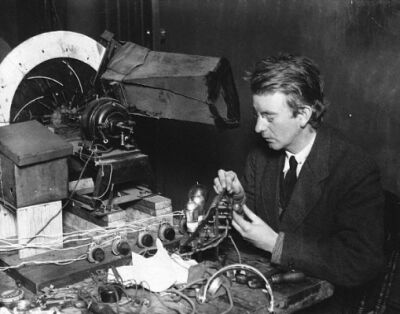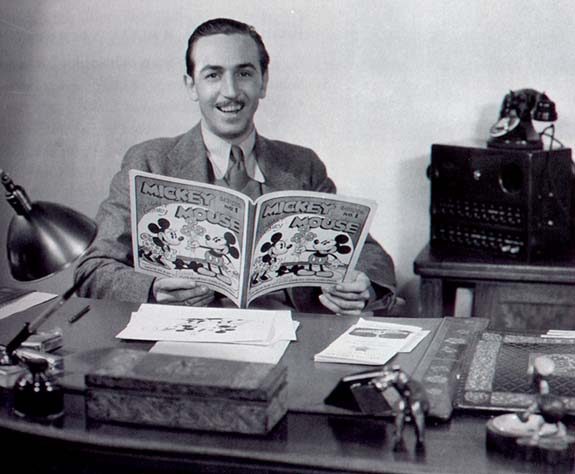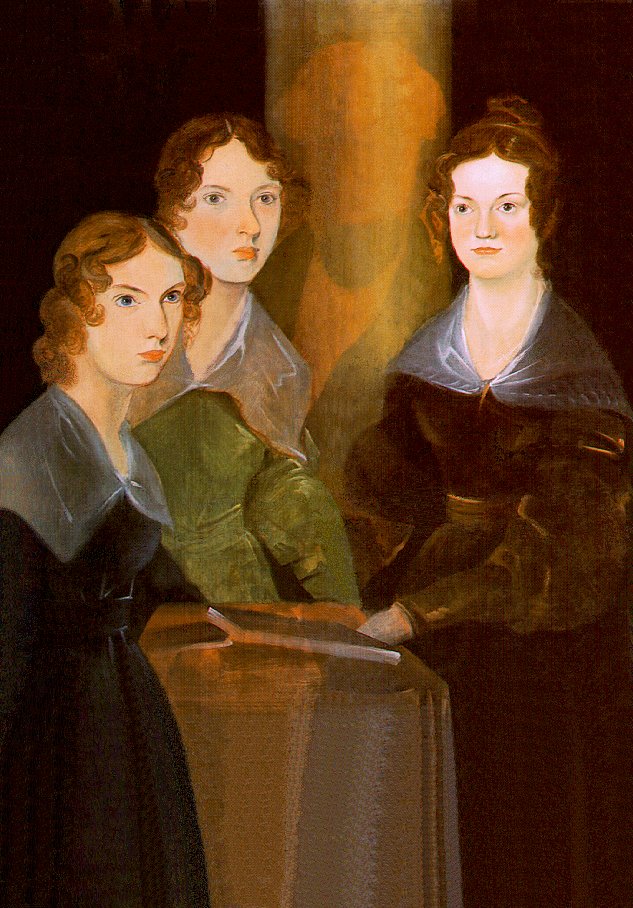Baird was a Scottish engineer, most famous for being the first person to demonstrate a working television.
John Logie Baird was born on 14 August 1888 in Helensburgh on the west coast of Scotland, the son of a clergyman. Dogged by ill health for most of his life, he nonetheless showed early signs of ingenuity, rigging up a telephone exchange to connect his bedroom to those of his friends across the street. His studies at the Glasgow and West of Scotland Technical College were interrupted by the outbreak of World War One. Rejected as unfit for the forces, he served as superintendent engineer of the Clyde Valley Electrical Power Company. When the war ended he set himself up in business, with mixed results.
Baird then moved to the south coast of England and applied himself to creating a television, a dream of many scientists for decades. His first crude apparatus was made of odds and ends, but by 1924 he managed to transmit a flickering image across a few feet. On 26 January 1926 he gave the world’s first demonstration of true television before 50 scientists in an attic room in central London. In 1927, his television was demonstrated over 438 miles of telephone line between London and Glasgow, and he formed the Baird Television Development Company. (BTDC). In 1928, the BTDC achieved the first transatlantic television transmission between London and New York and the first transmission to a ship in mid-Atlantic. He also gave the first demonstration of both colour and stereoscopic television.
In 1929, the German post office gave him the facilities to develop an experimental television service based on his mechanical system, the only one operable at the time. Sound and vision were initially sent alternately, and only began to be transmitted simultaneously from 1930. However, Baird’s mechanical system was rapidly becoming obsolete as electronic systems were developed, chiefly by Marconi in America. Although he had invested in the mechanical system in order to achieve early results, Baird had also been exploring electronic systems from an early stage. Nevertheless, a BBC committee of inquiry in 1935 prompted a side-by-side trial between Marconi’s all-electronic television system, which worked on 405 lines to Baird’s 240. Marconi won, and in 1937 Baird’s system was dropped.
Baird died on 14 June 1946 in Bexhill-on-Sea in Sussex.
Television experiments

The first known photograph of a moving image produced by Baird’s “televisor”, circa 1926 (The subject is Baird’s business partner Oliver Hutchinson)
An early experimental television broadcast.
The development of television was the result of work by many inventors, among them Baird was a prominent pioneer and made major advances in the field. Particularly in Britain, many historians credit Baird with being the first to produce a live, moving, greyscale television image from reflected light. Baird achieved this, where other inventors had failed, by obtaining a better photoelectric cell and improving the signal conditioning from the photocell and the video amplifier.
Between 1902 and 1907, Arthur Korn invented and built the first successful signal-conditioning circuits for image transmission. The circuits overcame the image-destroying lag effect that is part of selenium photocells. Korn’s compensation circuit allowed him to send still pictures by telephone or wireless between countries and even over oceans, while his circuit operated without benefit of electronic amplification.[6] Korn’s success at transmitting halftone still images suggested that such compensation circuits might work in television. Baird was the direct beneficiary of Korn’s research and success.
In his first attempts to develop a working television system, Baird experimented with the Nipkow disk. Paul Nipkow had invented this scanning disc system in 1884. Television historian Albert Abramson calls Nipkow’s patent “the master television patent”. Nipkow’s work is important because Baird and many others chose to develop it into a broadcast medium.
In early 1923, and in poor health, Baird moved to 21 Linton Crescent, Hastings, on the south coast of England and later rented a workshop in Queen’s Arcade in the town. Baird built what was to become the world’s first working television set using items including an old hatbox and a pair of scissors, some darning needles, a few bicycle light lenses, a used tea chest, and sealing wax and glue that he purchased. In February 1924, he demonstrated to the Radio Times that a semi-mechanical analogue television system was possible by transmitting moving silhouette images. In July of the same year, he received a 1000-volt electric shock, but survived with only a burnt hand. His landlord, Mr Tree, asked him to quit his workshop and he moved to upstairs rooms in Soho, London, where he made a technical breakthrough. Baird gave the first public demonstration of moving silhouette images by television at Selfridges department store in London in a three-week series of demonstrations beginning on 25 March 1925.
In his laboratory on 2 October 1925, Baird successfully transmitted the first television picture with a greyscale image: the head of a ventriloquist’s dummy nicknamed “Stooky Bill” in a 30-line vertically scanned image, at five pictures per second.[12] Baird went downstairs and fetched an office worker, 20-year-old William Edward Taynton, to see what a human face would look like, and Taynton became the first person to be televised in a full tonal range. Looking for publicity, Baird visited the Daily Express newspaper to promote his invention. The news editor was terrified: he was quoted by one of his staff as saying: “For God’s sake, go down to reception and get rid of a lunatic who’s down there. He says he’s got a machine for seeing by wireless! Watch him — he may have a razor on him
Further reading
Books
- Baird, John Logie, Television and Me: The Memoirs of John Logie Baird. Edinburgh: Mercat Press, 2004. ISBN 1-84183-063-1
- Burns, Russell, John Logie Baird, television pioneer. London: The Institution of Electrical Engineers, 2000. ISBN 0-85296-797-7
- Kamm, Antony, and Malcolm Baird, John Logie Baird: A Life. Edinburgh: NMS Publishing, 2002. ISBN 1-901663-76-0
- McArthur, Tom, and Peter Waddell, The Secret Life of John Logie Baird. London: Hutchinson, 1986. ISBN 0-09-158720-4.
- McLean, Donald F., Restoring Baird’s Image. The Institute of Electrical Engineers, 2000. ISBN 0-85296-795-0.
- Rowland, John, The Television Man: The Story of John Logie Baird. New York: Roy Publishers, 1967.
- Tiltman, Ronald Frank, Baird of Television. New York: Arno Press, 1974. (Reprint of 1933 ed.) ISBN 0-405-06061-0.
Credits:
BBC
Wikipedia
http://bairdtelevision.com/











